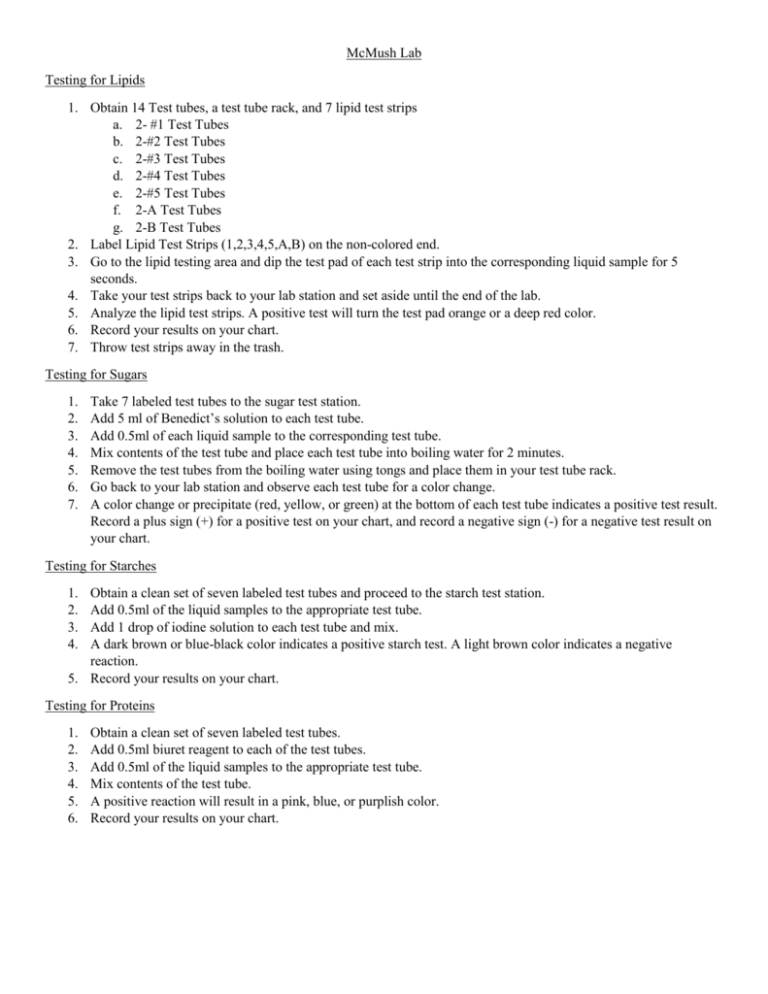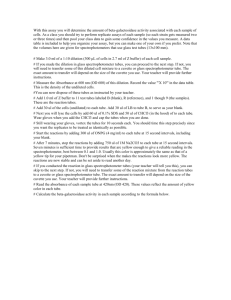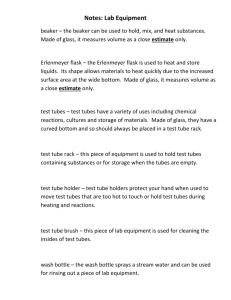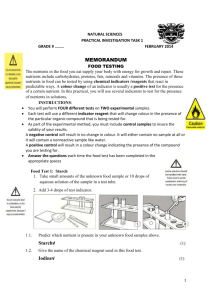McMush Lab Testing for Lipids Obtain 14 Test tubes, a test tube rack
advertisement

McMush Lab Testing for Lipids 1. Obtain 14 Test tubes, a test tube rack, and 7 lipid test strips a. 2- #1 Test Tubes b. 2-#2 Test Tubes c. 2-#3 Test Tubes d. 2-#4 Test Tubes e. 2-#5 Test Tubes f. 2-A Test Tubes g. 2-B Test Tubes 2. Label Lipid Test Strips (1,2,3,4,5,A,B) on the non-colored end. 3. Go to the lipid testing area and dip the test pad of each test strip into the corresponding liquid sample for 5 seconds. 4. Take your test strips back to your lab station and set aside until the end of the lab. 5. Analyze the lipid test strips. A positive test will turn the test pad orange or a deep red color. 6. Record your results on your chart. 7. Throw test strips away in the trash. Testing for Sugars 1. 2. 3. 4. 5. 6. 7. Take 7 labeled test tubes to the sugar test station. Add 5 ml of Benedict’s solution to each test tube. Add 0.5ml of each liquid sample to the corresponding test tube. Mix contents of the test tube and place each test tube into boiling water for 2 minutes. Remove the test tubes from the boiling water using tongs and place them in your test tube rack. Go back to your lab station and observe each test tube for a color change. A color change or precipitate (red, yellow, or green) at the bottom of each test tube indicates a positive test result. Record a plus sign (+) for a positive test on your chart, and record a negative sign (-) for a negative test result on your chart. Testing for Starches 1. 2. 3. 4. Obtain a clean set of seven labeled test tubes and proceed to the starch test station. Add 0.5ml of the liquid samples to the appropriate test tube. Add 1 drop of iodine solution to each test tube and mix. A dark brown or blue-black color indicates a positive starch test. A light brown color indicates a negative reaction. 5. Record your results on your chart. Testing for Proteins 1. 2. 3. 4. 5. 6. Obtain a clean set of seven labeled test tubes. Add 0.5ml biuret reagent to each of the test tubes. Add 0.5ml of the liquid samples to the appropriate test tube. Mix contents of the test tube. A positive reaction will result in a pink, blue, or purplish color. Record your results on your chart. McMush Assessment 1. Name at least three foods that would test positive for each of the macronutrients listed below: a. Lipids: b. Sugar: c. Starch: d. Protein: 2. Sample #1 was an egg albumin solution that served as a positive control for what macronutrient? 3. Sample #5 was distilled water. Explain the sample’s purpose and importance to your experiment. 4. Would you describe the tests that were performed in this experiment as being qualitative or quantitative? What is an advantage of using this form of nutrient testing? What is a disadvantage? 5. For healthy adults, the Recommended Dietary Allowance (RDA) for protein has been set at 0.8 grams per 2.2 pounds of body weight. Assuming you are an adult that weighs 140 pounds, calculate what your RDA for protein would be. 6. How are polymers and monomers different? 7. What are the monomers for the following macromolecules: a. Lipids: b. Carbohydrates: c. Proteins: d. Nucleic Acids: Multiple Choice 1. Which of the following compounds would NOT be classified as a carbohydrate? A. starch B. glucose C. enzymes D. cellulose E. deoxyribose 2. Carbohydrates are made of carbon, hydrogen and oxygen atoms. What is the typical ratio of these atoms to each other? A. 3:1 B. 1:2:1 C. 2:2:2 D. 4:2:4 E. 9:3:3:1 3. Monomers combine to form macromolecules through which of the following? A. hydrolysis reactions B. dehydration synthesis C. hydrophobic reactions D. hydrophilic synthesis E. carboxylation synthesis 4. Which of the following is not a lipid? A. oils B. fats C. chitins D. steroids E. triglycerides The following are chemicals used to test for the presence of macromolecules. I. Benedict’s solution II. Biuret reagent III. Lugol’s iodine IV. Test Strips 5. Mercedes is a vegetarian and has purchased a soy burger. She wants to determine if there is any protein and fat in her burger. Which of the above test(s) should she use? A. IV only B. I and II C. I and III D. II and III E. II and IV 6. Caleb has added 10 mL of food slurry to a test tube along with 3 mL of a blue colored chemical. He doesn’t remember which chemical he added, so he decides to heat the test tube. The slurry turned orange. Which of the chemicals had he added to the test tube? A. I only B. II only C. III only D. IV only E. III and IV The following are components of biomolecules. I. monosaccharide II. amino acid III. fatty acid IV. glycerol 7. Which monomer(s) comprise carbohydrates? A. I only B. II only C. III only D. II and III E. III and IV 8. Which are components of a lipid? A. I only B. II only C. III only D. II and III E. III and IV Free Response A pepperoni pizza slice was tested for the presence of biomolecules. Benedict’s solution, Biuret reagent, Lugol’s iodine, and test strips were used in the testing. Identify which components of the slice would test positive for each of the reagents. Justify your answer describing the color change expected for each positive result.





